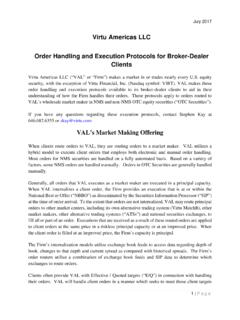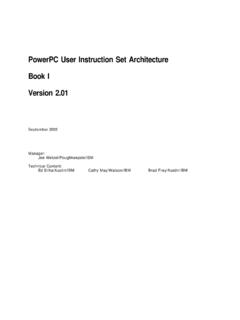Transcription of Integrating Project Management in Our Company
1 Integrating Project Management in Our Company Our explanations of Project Management should apply primarily to the processing of customer orders. But, since other activities also exhibit the same features mentioned above which characterize a Project , the following explanations also apply logically to the preparation of proposals/bids and the implementation of internal investment projects. Whether the Project concerns software, hardware or R & D, the procedure should almost always follow the same methods. Different demands require special procedures. We have therefore decided to divide our projects into different categories, or types. In this context, a simple classification feature is to be understood as a "type". Our objective is to follow a unified, standardized procedure in the processing of 70 to 80 percent of our orders. This category is Project Type "B". There will also be projects which require special treatment due to their scope, risk, strategic importance or level of innovation.
2 These are classified as belonging to Project Type "A". The rest are designated as Project Type "C". In this case, the Project manager decides whether and which parts of the methods can be omitted. Classification into types is based on a flow chart and is aided by an assessment table. Details are listed in the Project Management Manual. Project Management Manual: What's that? The Project Management Manual includes everything that a good Project manager must consider, know, and be able to do to be in the position to manage projects successfully. Through training and coaching, we and our Project managers pass on our knowledge and our experience. If handled in a systematic way, some claim that this is almost a type of "Knowledge Management ". Enough theory - let's proceed to actual practice. Based on our structural organization we have selected the balanced matrix organization model.
3 This means that the Project managers report directly to the head of their department. The tasks, authority and responsibilities (TAR) of every stakeholder in the Project are specified. These are also described in detail in the Project Management Manual. For the Project managers, the tasks, authority and responsibilities are defined at this point according to the following definitions, as an example for all other Project stakeholders: Tasks: Activities which are carried out by Project stakeholders during the Project itself. Authority: Describes the permission (setting the goal, decision-making, instructions and inspections) and therefore also the right to carry out these tasks and to take on responsibility. Responsibility: The obligation to third parties to fulfill agreements. TAR for a Project manager: Tasks Planning and coordination of Project work Investigation of the feasibility of Project goals Cost, schedule and quality control, control of financial result Planning and request of resources Coordination and Management of team members Reporting to steering committee and Project team members Calling of team/milestone meetings Preparation and updating of Project documentation Acting as Contact person for the customer Risk analysis and prevention Change order and claim Management Instigation and execution of corrective actions Employee evaluation reports as requested by line managers Recommendations on personnel development Authority "Temporary Managing Director".
4 Setting priorities for Project execution Direct access to all Project -related data Right of recommendation for composition of teams Delegation of tasks to the Project team Supervision of team members work Request for materials and for personnel resources Establishing the agenda of team and milestone meetings Responsibility Fulfillment of scheduling and cost goals, with the objective of possible maximization of profit Fulfilling the Project order Planned sequence of the Project , including Project documentation Solving conflicts within the Project After we have ensured that the Project manager and also the stakeholders in the Project know where they stand and where they are included in the organization of our Company , we can begin to work on what must be considered and has to be done during Project execution. The procedural organization for Project Type "B" is our standard.
5 It includes all of the following procedural steps. The standards of quality specified by DIN EN ISO 9001 are met. For special cases, especially for "A" projects, it is of course possible to establish regulations which deviate from this method. Due to the direct subordination of the Project manager below the head of department, it is necessary to regulate the collaboration between the functional departments and the Project manager. The Project manager is responsible for what should be done when, and at what cost. The functional department is responsible for who does it, and how. A large number of employees in our Company participate in Project execution. Everyone who works directly within the Project team, and the managers and employees of the functional departments therefore are stakeholders in the Project . But how about the customers, the suppliers, the authorities and planners - shouldn't they also be seen as Project stakeholders?
6 In addition to the Project manager, the steering committee plays an essential role. It is a controlling organ. The managing directors assign the steering committee to "A" projects, otherwise this is the duty of the specific head of the department. The decision-making authority in dependent relation to the Project requirements is therefore delegated to the steering committee. Members of the steering committee are the head of department, the head of the relevant functional department (there may be more than one) and a qualified commercial expert who exercises a "controlling function". For "A" projects and especially important "B" projects, a member of the managing directors will also be included in the steering committee.





